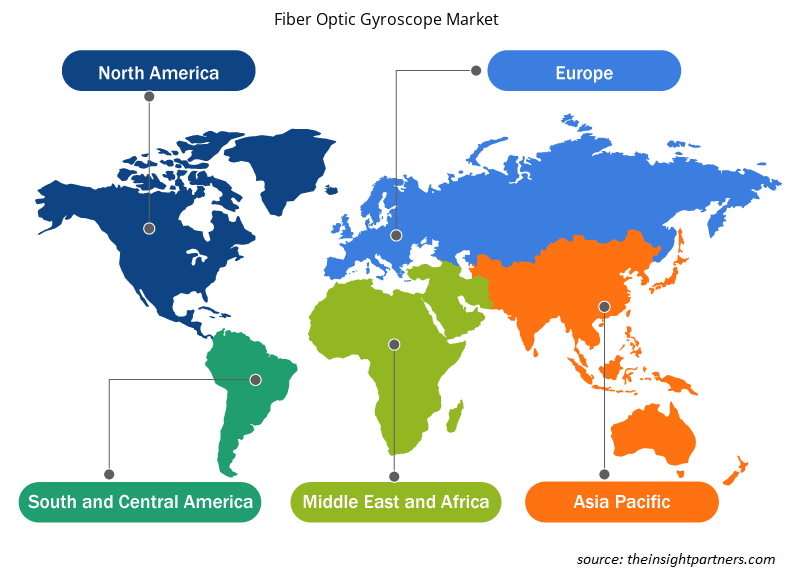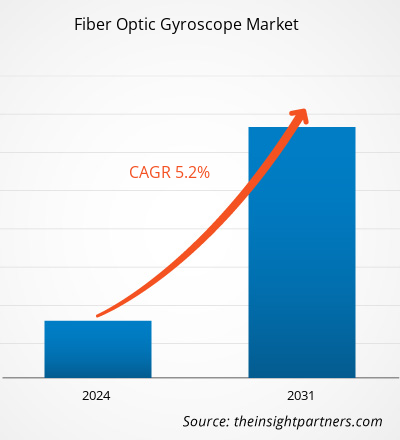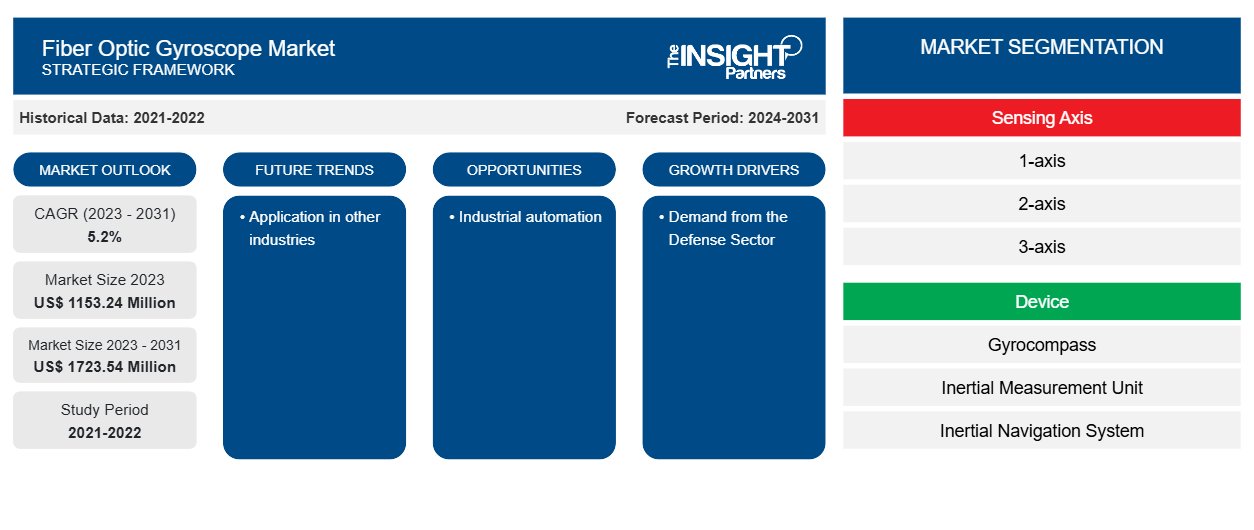Der Markt für faseroptische Gyroskope soll von 1.153,24 Millionen US-Dollar im Jahr 2023 auf 1.723,54 Millionen US-Dollar im Jahr 2031 anwachsen. Der Markt soll zwischen 2023 und 2031 eine durchschnittliche jährliche Wachstumsrate (CAGR) von 5,2 % verzeichnen. Der Anstieg der Militärausgaben und die Vorteile, die faseroptische Gyroskope bieten, werden voraussichtlich weiterhin die wichtigsten Trends auf dem Markt für faseroptische Gyroskope bleiben.
Marktanalyse für faseroptische Gyroskope
Aufgrund der zahlreichen Vorteile von Glasfaser-Gyroskopen, wie z. B. geringe Größe, geringes Gewicht, geringer Stromverbrauch, lange Lebensdauer, hohe Zuverlässigkeit und Massenproduktion, werden Glasfaser-Gyroskope in verschiedenen Branchen wie der Luft- und Raumfahrt, der Verteidigung, in Industriezweigen und anderen nachgefragt. Somit fördert die Nachfrage aus verschiedenen Branchen das Marktwachstum. Darüber hinaus treibt das weltweite Wachstum der Militärausgaben aufgrund der Konzentration der Regierung auf die Stärkung ihres Militärsektors die Nachfrage nach Glasfaser-Gyroskopen in ferngesteuerten Fahrzeugführungsanwendungen an.
Marktübersicht für faseroptische Gyroskope
Ein Glasfaser-Gyroskop wird zur Messung der Winkelgeschwindigkeit verwendet und kommt in verschiedenen Anwendungen zum Einsatz, von der Raketennavigation bis zur Bewegungssteuerung. Glasfaser-Gyroskope haben gegenüber anderen Gyroskoptypen mehrere Vorteile, darunter geringes Gewicht, geringe Größe, lange Lebensdauer, geringer Stromverbrauch, hohe Zuverlässigkeit und Massenproduktion. Für die Navigation, Lenkung und Steuerung von Raketen, Flugzeugen, Robotern, Autos, Raumfahrzeugen usw. ist es ein besonders wichtiges Werkzeug.
Passen Sie diesen Bericht Ihren Anforderungen an
Sie erhalten kostenlos individuelle Anpassungen an jedem Bericht, einschließlich Teilen dieses Berichts oder einer Analyse auf Länderebene, eines Excel-Datenpakets sowie tolle Angebote und Rabatte für Start-ups und Universitäten.
-
Holen Sie sich die wichtigsten Markttrends aus diesem Bericht.Dieses KOSTENLOSE Beispiel umfasst eine Datenanalyse von Markttrends bis hin zu Schätzungen und Prognosen.
Markttreiber und Chancen für faseroptische Gyroskope
Nachfrage der Marktteilnehmer aus dem Verteidigungssektor begünstigt den Markt
Mehrere Vorteile von Glasfaserkreiseln, darunter eine hohe Rotationsgeschwindigkeit und eine hohe Auflösung im Vergleich zu ihren Ersatzprodukten, wie etwa Alternativen wie mechanischen Kreiseln und Ringlaserkreiseln, begünstigen ihre Verbreitung im Verteidigungssektor. Aufgrund dieser Vorteile erhalten die Marktteilnehmer Aufträge, die den Markt für Glasfaserkreisel fördern. So gab KVH Industries, Inc. (Nasdaq: KVHI) im August 2021 bekannt, dass es einen Auftrag über 7,9 Millionen US-Dollar für Glasfaserkreisel (FOG) von Escribano, einem spanischen Verteidigungsunternehmen, für seinen neuen ferngesteuerten Geschützturm Guardian 30 erhalten hat.
Anwendung in anderen Branchen – Eine Chance auf dem Markt für faseroptische Gyroskope
Faseroptische Gyroskope wurden ursprünglich für militärische und Verteidigungszwecke entwickelt. Aufgrund ihrer potenziellen Vorteile gegenüber anderen Gyroskoptypen werden sie jedoch auch in anderen Branchen, darunter in kommerziellen und industriellen Sektoren weltweit, häufig eingesetzt. Auch in der Automobil-, Medizin- und Roboterindustrie besteht eine starke Nachfrage nach faseroptischen Gyroskopen. Die steigende Nachfrage nach technologisch fortschrittlichen Lösungen zur Verbesserung der Betriebseffizienz in mehreren Branchen und der wachsende Trend zur industriellen Automatisierung treiben die Nachfrage nach faseroptischen Gyroskopen weiter an.
Segmentierungsanalyse des Marktberichts für faseroptische Gyroskope
Wichtige Segmente, die zur Ableitung der Marktanalyse für faseroptische Gyroskope beigetragen haben, sind Sensorachse, Gerät und Anwendung.
- Basierend auf der Sensorachse ist der Markt in 1-Achsen, 2-Achsen und 3-Achsen segmentiert. Das 3-Achsen-Segment hatte im Jahr 2023 einen größeren Marktanteil.
- Nach Geräten ist der Markt in Kreiselkompass, Trägheitsmesseinheit, Trägheitsnavigationssystem und Lagereferenzsystem unterteilt. Das Segment der Trägheitsmesseinheit hatte im Jahr 2023 den größten Marktanteil.
- Nach Anwendung ist der Markt in taktische Anwendungen, ferngesteuerte Fahrzeugführung, Luft- und Raumfahrt, Robotik sowie Verteidigung und Heimatschutz unterteilt. Das Segment Verteidigung und Heimatschutz hatte im Jahr 2023 den größten Marktanteil.
Marktanteilsanalyse für faseroptische Gyroskope nach geografischer Lage
Der geografische Umfang des Marktberichts für faseroptische Gyroskope ist hauptsächlich in fünf Regionen unterteilt: Nordamerika, Asien-Pazifik, Europa, Naher Osten und Afrika sowie Südamerika/Süd- und Mittelamerika.
Gemessen am Umsatz hatte Nordamerika im Jahr 2023 den größten Marktanteil bei faseroptischen Gyroskopen. Der asiatisch-pazifische Raum dürfte im Prognosezeitraum mit der höchsten CAGR wachsen.
Der anhaltende Drang der Streitkräfte nach neuen Technologien für Kampf- und Nichtkampfeinsätze treibt die Verteidigungsausgaben in Nordamerika in die Höhe. Nach Angaben des Stockholmer Friedensforschungsinstituts (SIPRI) erreichten die Militärausgaben der USA, des weltweit größten Militärausgabenträgers, im Jahr 2022 877 Milliarden US-Dollar, was 39 Prozent der gesamten globalen Militärausgaben entspricht und dreimal mehr ist als der Betrag, den China, der weltweit zweitgrößte Militärausgabenträger, ausgibt. Solche Militärausgaben führen zu einer Nachfrage nach fortschrittlicher Technologie für zuverlässige und genaue Navigationssysteme in Flugzeugen und Raketen, was wiederum Glasfaserkreisel erfordert, da diese eine höhere Genauigkeit bieten.
Regionale Einblicke in den Markt für faseroptische Gyroskope
Die regionalen Trends und Faktoren, die den Markt für Glasfasergyroskope im Prognosezeitraum beeinflussen, wurden von den Analysten von Insight Partners ausführlich erläutert. In diesem Abschnitt werden auch die Marktsegmente und die Geografie von Glasfasergyroskopen in Nordamerika, Europa, im asiatisch-pazifischen Raum, im Nahen Osten und Afrika sowie in Süd- und Mittelamerika erörtert.

- Erhalten Sie regionale Daten zum Markt für faseroptische Gyroskope
Umfang des Marktberichts über faseroptische Gyroskope
| Berichtsattribut | Details |
|---|---|
| Marktgröße im Jahr 2023 | 1153,24 Millionen US-Dollar |
| Marktgröße bis 2031 | 1723,54 Millionen US-Dollar |
| Globale CAGR (2023 - 2031) | 5,2 % |
| Historische Daten | 2021-2022 |
| Prognosezeitraum | 2024–2031 |
| Abgedeckte Segmente |
Nach Sensorachse
|
| Abgedeckte Regionen und Länder |
Nordamerika
|
| Marktführer und wichtige Unternehmensprofile |
|
Marktteilnehmerdichte für Glasfaser-Gyroskope: Auswirkungen auf die Geschäftsdynamik verstehen
Der Markt für Glasfaser-Gyroskope wächst rasant, angetrieben durch die steigende Nachfrage der Endnutzer aufgrund von Faktoren wie sich entwickelnden Verbraucherpräferenzen, technologischen Fortschritten und einem größeren Bewusstsein für die Vorteile des Produkts. Mit steigender Nachfrage erweitern Unternehmen ihr Angebot, entwickeln Innovationen, um die Bedürfnisse der Verbraucher zu erfüllen, und nutzen neue Trends, was das Marktwachstum weiter ankurbelt.
Die Marktteilnehmerdichte bezieht sich auf die Verteilung der Firmen oder Unternehmen, die in einem bestimmten Markt oder einer bestimmten Branche tätig sind. Sie gibt an, wie viele Wettbewerber (Marktteilnehmer) in einem bestimmten Marktraum im Verhältnis zu seiner Größe oder seinem gesamten Marktwert präsent sind.
Die wichtigsten auf dem Markt für faseroptische Gyroskope tätigen Unternehmen sind:
- Erweiterte Navigation
- Cielo Inertial Solutions Ltd.
- iXblue
- Emcore Corporation
- Physikalische Optik
- Honeywell International Inc
Haftungsausschluss : Die oben aufgeführten Unternehmen sind nicht in einer bestimmten Reihenfolge aufgeführt.

- Überblick über die wichtigsten Akteure auf dem Markt für faseroptische Gyroskope
Neuigkeiten und aktuelle Entwicklungen zum Markt für faseroptische Gyroskope
Der Markt für Glasfaser-Gyroskope wird durch die Erfassung qualitativer und quantitativer Daten nach Primär- und Sekundärforschung bewertet, die wichtige Unternehmensveröffentlichungen, Verbandsdaten und Datenbanken umfasst. Im Folgenden finden Sie eine Liste der Entwicklungen auf dem Markt:
- Im Januar 2024 kündigte Advanced Navigation seine neue Produktreihe von Trägheitsnavigationssystemen (INS) mit Glasfaserkreiseln an: Boreas. Boreas ist ein hochpräzises INS der strategischen Klasse, das im Vergleich zu Konkurrenzsystemen 40 % weniger Größe, Gewicht, Stromverbrauch und Kosten bietet. Boreas ist das erste Produkt auf dem Markt, das auf der neuen DFOG-Technologie (Digital Fibre Optic Gyroscope) von Advanced Navigation basiert, die das Ergebnis einer 25-jährigen Entwicklung unter Beteiligung zweier Forschungseinrichtungen ist. Boreas ist auf Anwendungen ausgerichtet, die eine stets verfügbare, hochpräzise Orientierung und Navigation erfordern, darunter Seefahrt, Vermessung, Unterwasser, Luft- und Raumfahrt, Robotik und Weltraum. (Quelle: Advanced Navigation, Pressemitteilung, 2024)
- Im September 2021 kündigten die iXblue-Teams die Einführung der UmiX-Serie an. Diese hochmoderne Reihe von Trägheitsmesseinheiten (IMU) basiert auf der faseroptischen Gyroskop-Technologie (FOG). (Quelle: iXblue, Pressemitteilung, 2021)
Marktbericht zu faseroptischen Gyroskopen – Abdeckung und Ergebnisse
Der Bericht „Marktgröße und Prognose für faseroptische Gyroskope (2021–2031)“ bietet eine detaillierte Analyse des Marktes, die die folgenden Bereiche abdeckt:
- Marktgröße und Prognose auf globaler, regionaler und Länderebene für alle wichtigen Marktsegmente, die im Rahmen des Projekts abgedeckt sind
- Marktdynamik wie Treiber, Beschränkungen und wichtige Chancen
- Wichtige Zukunftstrends
- Detaillierte PEST/Porters Five Forces- und SWOT-Analyse
- Globale und regionale Marktanalyse mit wichtigen Markttrends, wichtigen Akteuren, Vorschriften und aktuellen Marktentwicklungen
- Branchenlandschaft und Wettbewerbsanalyse, einschließlich Marktkonzentration, Heatmap-Analyse, prominenten Akteuren und aktuellen Entwicklungen
- Detaillierte Firmenprofile
- Historische Analyse (2 Jahre), Basisjahr, Prognose (7 Jahre) mit CAGR
- PEST- und SWOT-Analyse
- Marktgröße Wert/Volumen – Global, Regional, Land
- Branchen- und Wettbewerbslandschaft
- Excel-Datensatz
Aktuelle Berichte
Verwandte Berichte
Erfahrungsberichte
Grund zum Kauf
- Fundierte Entscheidungsfindung
- Marktdynamik verstehen
- Wettbewerbsanalyse
- Kundeneinblicke
- Marktprognosen
- Risikominimierung
- Strategische Planung
- Investitionsbegründung
- Identifizierung neuer Märkte
- Verbesserung von Marketingstrategien
- Steigerung der Betriebseffizienz
- Anpassung an regulatorische Trends























 Kostenlose Probe anfordern für - Markt für faseroptische Gyroskope
Kostenlose Probe anfordern für - Markt für faseroptische Gyroskope